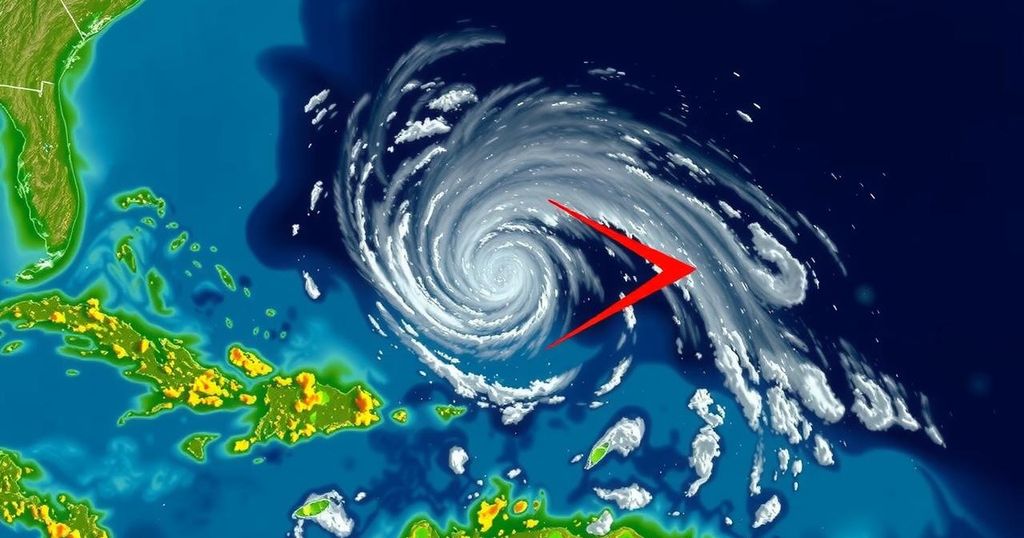Hurricane Rafael Threatens Development of Tropical Storm Sara in Atlantic

Chances are rising for a system in the southwestern Atlantic to develop into Tropical Storm Sara, yet Hurricane Rafael could impede this formation. Rafael became a Category 2 hurricane and is set to strengthen before making landfall in Cuba. The potential for Sara’s development remains low due to Rafael’s proximity, complicating forecasts for the northern Caribbean and southern Bahamas.
As Tropical Storm Sara potentially looms, conditions in the southwestern Atlantic exhibit a 30 percent chance of this system strengthening into a named storm. However, Hurricane Rafael, which recently intensified to Category 2 status with maximum sustained winds of 115 mph, poses a threat to its development. Meteorologists predict Rafael will continue to strengthen before making landfall in Cuba, complicating the formation of Tropical Storm Sara further and affecting its trajectory toward the northern Caribbean and the southern Bahamas. Hurricane Rafael achieved hurricane status on Tuesday night, with expectations that it will intensify before its anticipated landfall in Cuba. Although Rafael is expected to weaken after crossing Cuba, it will likely emerge into the Gulf while still retaining hurricane status. The National Hurricane Center has noted that the system in the southwestern Atlantic has a mere 20 percent chance of forming within the next 48 hours, and should it develop, it will be designated as Storm Sara, the eighteenth system of the 2024 Atlantic hurricane season. AccuWeather meteorologists emphasize the low likelihood of development for the potential system in the Atlantic, indicating that Rafael’s presence significantly diminishes its chances. Senior meteorologist Alan Reppert stated, “The current track of Rafael affects the chances to develop over the next few days from being close by.” Moreover, Reppert warned that Rafael could disrupt the nascent system, asserting that contrary conditions and the proximity of Rafael render the development of Sara unlikely. Should the system successfully develop, it may influence the northern Caribbean region and the southern Bahamas, with potential impacts predicted for Florida. The National Hurricane Center has not issued a projected path due to the system being unnamed, but early forecasts suggest targeting Florida is plausible. There is also a possibility of disorganized showers and thunderstorms moving toward the northern Leeward Islands, advancing westward in the coming days. Regardless of whether Tropical Storm Sara materializes, the existing system is expected to induce rainfall across the northern Caribbean and southern Bahamas area. Although Rafael’s strengthening could offer some defense for Florida against another storm, it brings uncertain hazards to the Florida Keys, including coastal flooding and the risk of tornadoes amid its passage nearby.
The article discusses the developing weather situation in the southwestern Atlantic, where the possibility of the formation of Tropical Storm Sara arises amid the backdrop of Hurricane Rafael’s activity. Hurricane Rafael, which recently intensified, is anticipated to continue strengthening, creating environmental conditions that could inhibit the development of the adjacent system. The context highlights how existing storms can influence emerging weather patterns in the region, particularly in the hurricane season.
In conclusion, Hurricane Rafael’s advancement may hinder the potential development of Tropical Storm Sara in the southwestern Atlantic with low probabilities of formation facing off against Rafael’s strength. While the National Hurricane Center monitors both systems, Rafael’s trajectory and development will likely dictate the weather conditions in the vicinity of the Caribbean. Regardless of the outcomes regarding Tropical Storm Sara, Rafael is poised to create indirect threats to Florida, necessitating close observation by meteorologists and residents alike.
Original Source: www.newsweek.com







